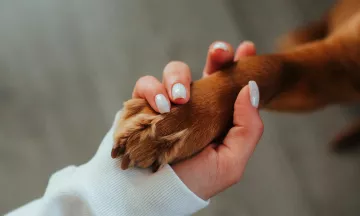Why do pets get separation anxiety at the start of the school term?
Dogs and cats are intuitive enough to pick up on changes in the household routine, which can lead to stress and separation anxiety.

From your pet's perspective, they have been enjoying a full house with plenty of noise, walks and playtime. Maybe you even took them on holidays or had a pet sitter come to stay.
Suddenly, the house is hectic with prepping lunches, packing bags and rushing out the door. Then, when the house suddenly falls silent and empty, your pet is left confused and stressed as to where their family has gone. Unfortunately, this pent-up anxiety and energy can lead to problem behaviours. For example, your perfectly behaved pet may start chewing, going to the toilet in unwelcomed places or scratching furniture.
Fear not: there are some ways we can help our pets prepare and adjust to this change. Here are some top tips for tackling back-to-school separation anxiety in pets:
1) Practice your morning routine in advance
It's a good idea to practice your morning ritual for a few days before you leave the house. Doing so will allow your pet to adjust to the sound of keys being grabbed and shoes going on, leading to less fretting on the big day.
Keep items such as school bags out, so your pet can get used to them being around. You may even ask your kids to practice getting into their uniforms or wear their bags around the house a few times without leaving. Your pet will soon learn that these objects aren't threatening!

2) Stay calm when you leave the house
Your pet knows you extremely well and can pick up on unusual body language and mood. As such, stay cool and calm on the first morning of school. Have everything prepped and in place the night before so you can move through your morning with minimal stress.
If your pet barks or frets in the morning, try not to reward this behaviour by giving it too much focus. Instead, redirect their attention to a chew toy or kong.
3) Leave some quiet music on
Some pets seem to relax when they can hear low, calm music or the radio. In fact, there have been several studies into this phenomenon, leading to many soothing online playlists for pets! At the very least, it makes sense that a pet will adjust to being alone if there is a bit of background noise compared to complete silence. As such, leave the TV or radio on low when you leave the house or download a classical music playlist for your pet to bliss out to.
4) Make time for exercise
Factor in your pet's exercise routine around school pick up and drop off. This will make the world of difference for your pet! A dog will remain a lot calmer throughout the day if it can burn some mental or physical energy in the form of a walk or stimulating training session. Ideally, you should give your pet some focused play/exercise time in the morning and evening. Perhaps the kids can incorporate your dog or cat into their pre-homework ritual.
Interactive toys and slow feeders are also great to mix up your pet's routine. Hide treats around the house or in a kong or set up some cardboard boxes for your cat to explore and nap in. You don't have to spend a fortune - here are some tips for homemade dog toys, and homemade cat scratching posts.

5) Hire a pet sitter
A friendly pet sitter can stop by during the day and give your pet plenty of cuddles and playtime. This is a great way to help your pet adjust to the school term. Plus, your family can head back to school guilt-free knowing your pet has a human pal to keep them company.
Finding a pet sitter is easy! Simply head to the link below and enter your suburb in the search bar. Browse the list of profiles near you, and send a message with your dates and requirements.





